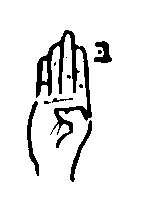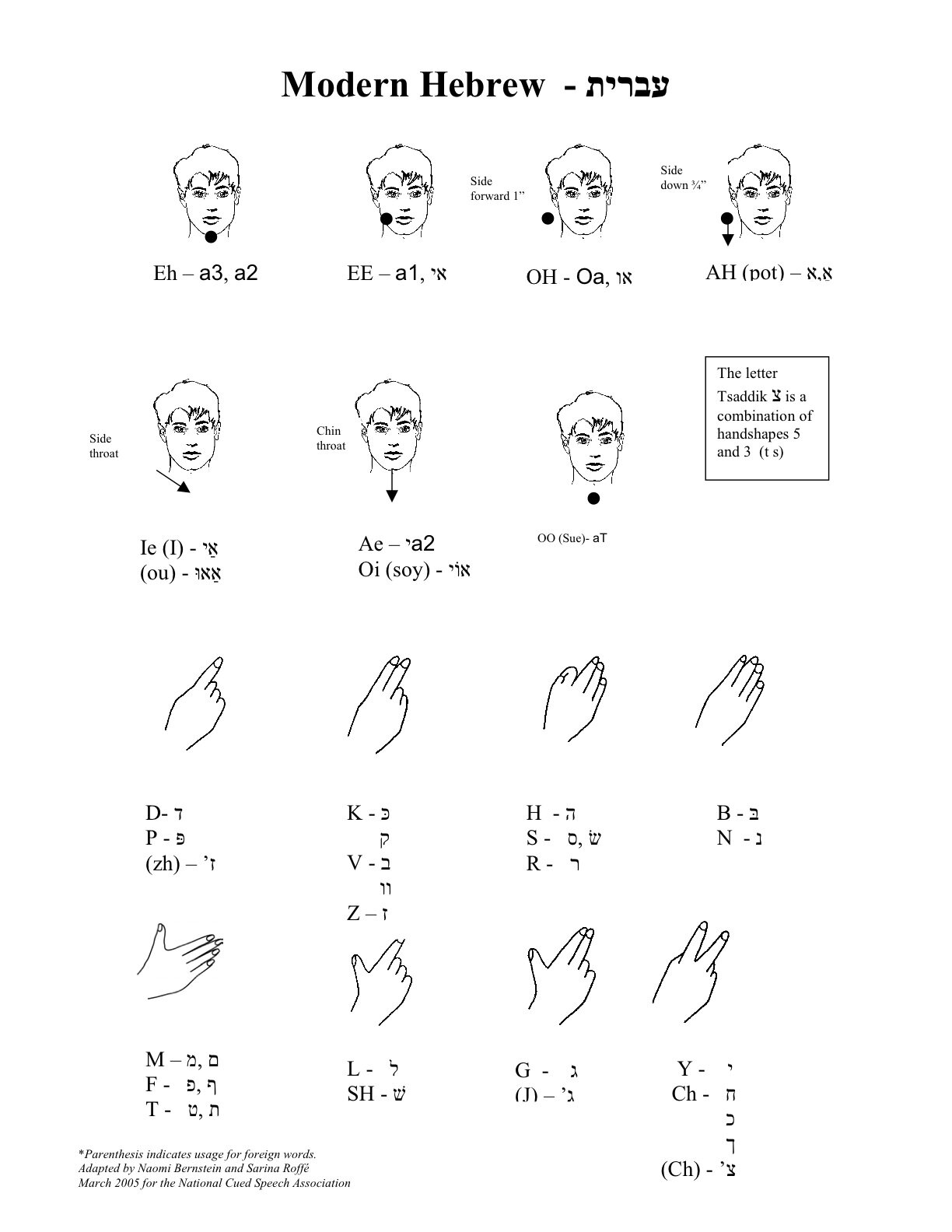
Interpreting for Hebrew: Language classes, Sunday school, religious services, Torah study, and sermons.1







Introduction
Occasionally an interpreter is confronted with a text that includes words from a foreign language, be it a scholarly quote in Latin or Greek or a clever saying in Spanish or French. At this point we usually trust the speaker to translate it into English momentarily, and while we're waiting we merely sign NOW SPEAK FOREIGN LANGUAGE, or if we recognize the language we would say which one it was. What happens when the consumer wants you to represent the foreign language itself? I hope to make some suggestions that would be helpful to an ASL interpreter for such a setting, using my experience interpreting for such settings.
Preparation
The task is difficult enough without having a previous knowledge of the language being taught. Interpreters for foreign language classes really should have had at least two years of instruction in the foreign language they will interpret, even for an introductory course in that language. This would be also true for the other settings we are called upon to represent Hebrew, such as for a consumer who is knowledgeable or wishes to become knowledgeable in Hebrew. It may have been years since the interpreter used the Hebrew they learned in school, but with some preparation before each class it will come back to them. If they start by interpreting the first introductory course, they will relearn it with ease. We will mainly focus on Hebrew language courses, but with a little reworking, this would fit in other settings, too. As a last resort, interpreters with no knowledge of the language can start by interpreting Hebrew 1 and working their way up. Increasing numbers of interpreters have a third language, besides ASL and English, and I believe that a third language, whether it's a spoken language or a signed language, is very helpful for further breaking away from the unavoidable ethnocentrism that monolinguals may have.
Having the textbook for the class is essential. By following the syllabus and reading ahead, the interpreter can know which aspects of the language and which vocabulary items will be dealt with in class on any given day. Remember to bring the book to class because it will help you let the D/deaf students know where you are. The teacher may ask a question from the book without mentioning the number of the question, and by checking your copy of the book you can tell them where to read, instead of laboriously fingerspelling the question when they could get it faster by reading it in the text. If the students are reading an extended passage from the book, you might as well tell the D/deaf students where the class is in the textbook and have them read along. It may be difficult for you to understand some hearing students when they read Hebrew or speak it. We know that it takes more effort to interpret a speaker with a heavy accent or a foreign Deaf person who may have remnants of his/her foreign sign language mixed into their ASL. All the more so when we hear mispronounced Hebrew, which is at best a second language for most of us. Having the book turned to the right page may help you use cloze to figure out which Hebrew words they are trying to pronounce.
Doing the homework is also very helpful, especially if the language is new to the interpreter or has been unused for several years. If the interpreter does not wish to purchase the textbook and cannot get a copy from the teacher or library, it is possible to order a desk copy2 by writing to the publisher. If that doesn't work, xerox the pages you need, use an old Hebrew text, or borrow the teacher's text at a regular time when you are free and the teacher is busy with other things. Consider tutoring or working together with the student if you are reasonably competent in the language. If you are just learning Hebrew with the class you can still use the time to figure out together how Hebrew works and what the student thinks would work best for her/himself in terms of representing the language using ASL, DGS (Hebrew Sign Language), fingerspelling, or Cued Speech.
Orthographic challenges
Fingerspelling every word would definitely represent a foreign language exactly if it doesn't have a different alphabet, but it is just too much for most D/deaf people's eyes and the interpreter's hands. Hebrew does have its own alphabet, so spelling it phonetically won't be of much help, since the student won't see it written this way in class. For non-academic settings like synagogue or classes that don't require a knowledge of the Hebrew alephbet because everything is transliterated3 into Roman ("English") letters, this won't be an issue. For Hebrew classes, it will still be necessary to fingerspell at least some words to introduce them, emphasize them, talk about spelling, and show affixes, declensions, and conjugations.
In order to use Israeli fingerspelling, the interpreter should make copies of a Shasi (S'fat haSimanim shel Israel - Israeli Sign Language) fingerspelling chart. Both the interpreter and the consumer will probably want to bring this chart to class until the fingerspelling becomes more second-nature to them. See "Israeli fingerspelling chart" under the web resources at the end of this web page. Books written in modern Hebrew will only show the consonants, unless they occasionally need to disambiguate a word. Those written in Biblical or Mishnaic Hebrew will often show the vowels as well, which are smaller diacritical marks above or below the letters. Israeli fingerspelling charts will also show these vowels. Some Hebrew letters have a different form if they are at the end of a word. These are also indicated.
 4Phonological challenges
4Phonological challenges
Every language has a slightly different phonology or way to pronounce its letters. The interpreter needs to find out what the students want from their course. Do they want to learn how to pronounce, speechread, or only read and write the language? This is a good discussion to have with the teacher present, so that s/he can become aware of what modifications might need to be made. This will bring up the broader questions of how the D/deaf student should recite: using voice, fingerspelling everything, some sign and some fingerspelling, or cued speech.
Cued Speech could come in very handy for representing a foreign language if the consumer knows it or wishes to learn it, since it represents the pronunciation (and the individual words) in a way that the eye can take in, rather than fingerspelling every word. Languages like French offer difficulty in so far as the pronunciation does not correspond to the spelling, but this is the same difficulty that hearing students have with such languages. As mentioned above, phonologies differ, so special cueing systems have been developed to represent phonemes that do not exist in English. For Hebrew, the problem letters in terms of pronunciation are ח, כ, and ר.
Here is a chart of the Cues for Hebrew:

Semantic challenges
Representing form or meaning is a choice that interpreters make daily as they decide what the goal of the communication is (such as the title of a book, a technical phrase, or a common saying) and what the communication mode of the consumer is (ASL or PSE) . All of us are familiar with the difficulty of representing English in ASL, and I personally agree with those that feel English should not be taught to the D/deaf through signing, but should be taught as a written language with explanations in ASL. This would probably work best for foreign languages also, but D/deaf people certainly have a right of access to foreign language classes, especially if this is the only way they can satisfy their degree requirements for a foreign language.
There is a teaching method using computers which is generally referred to as CALL (Computer-Assisted Language Learning), although specific programs have been developed with their own names. If such programs are available at the school where the foreign language is being taught, the teacher may be able to give the deaf person guidance on how to use the computer programs to good effect, since they serve to promote reading and writing, rather than working through an auditory mode. See the bibliography for some articles on this methodology.
An exciting development has been the blossoming of awareness about foreign sign languages. I look forward to the day that D/deaf people can get academic credit for learning these sign languages as well. It may be instructive to skim a sign language for the country whose spoken language you are interpreting. Consult with the D/deaf person to see if they wish you to use foreign signs to represent some of the frequently occurring words in the foreign spoken language they are learning. Some very basic words may be helpful to know how to sign in this language. Concepts in the language that have no English equivalent could be negotiated in this way, and as a matter of fact ASL is now incorporating such signs as SUSHI, SMORGASBORD, and VODKA. Israeli Sign Language texts are cited in the bibliography.
We've alluded to the difficulty of teaching English in ASL, and it's even more complicated for other spoken languages. Foreign countries, especially if they have a strong contingent that support oralism, may have an invented system (parallel to Manual Codes for English) to represent their spoken language, but this requires that the D/deaf person learn three languages: the written language, the signed language, and the manual code! Invented systems would not be beneficial anyway, for the same reason that MCEs only lead to confusion and are dropped by students and even teachers inadvertently due to their visual clumsiness.
The method I have used is unvoiced Sim-Com, that is, mouthing Hebrew while simultaneously using conceptually accurate ASL signs and fingerspelling. The method you decide to use should be negotiated with your consumer. If there is no one-to-one match between English and ASL, which share some of the same culture, imagine trying to find one ASL sign for a given Hebrew word! This is where sign negotiation comes in. You will feel more needed then ever if you interpret a Hebrew course, because there are a limited number of Hebrew-speaking interpreters.
Here is a guide to some of the kinds of words that are helpful to fingerspell. For all sentences I would emphasize again to mouth the Hebrew: it emphasizes to the students that Hebrew is being represented, not English; it may remind the students of some of the Hebrew words, if they can speechread them; and it helps the interpreter attend to finding lexical equivalents for Hebrew and ASL (no easy task!)
(1) Words or phrases that are being introduced for the first few times - For example, the teacher says, "אני רוצה אוף". Suppose the student has already learned "ani" and "rotseh/rotsah", but the Hebrew word "oph" is new. While mouthing "ani rotseh/rotsah (depending on the teacher's gender)", the interpreter could sign (while mouthing the Hebrew) ME WANT in ASL or ANI ROTSEH/ROTSAH in Shasi. Since the word "oph" is new, the interpreter should fingerspell א–ו–ף. If the teacher has already introduced the meaning of this word, the interpreter could add the ASL sign BIRD or CHICKEN. For a word or phrase that comes up often, it is a good time to show the Shasi sign if known. A good example of this would be the phrase מה שלומך? When this is first introduced, the interpreter should fingerspell מה שלומך?. Later when this is learned, the interpreter could sign HOW YOU? (while mouthing the Hebrew) or using the Shasi sign MAH-SHLOMCHA/SHLOMAICH?, which is an F handshape, palm facing the chest, fingertips facing the non-dominant side, brushing up the dominant side of the chest several times while the non-dominant hand points to "you". Obviously it will be difficult to learn or find all the Shasi signs you need, but it is something to play with if helpful.
(2) In the present tense, Hebrew verbs are inflected for gender and plurality. The interpreter can add the fingerspelled י–ם for masculine plural or the fingerspelled ו–ת for feminine plural to whatever sign is being used to represent the base verb. Verbs become even more inflected for past and future tenses. If the focus of the sentence is the verb structure, the interpreter will need to fingerspell the verb or at least the ending, If the inflected verb is not the focus of the sentence, such as when other new vocabulary is being introduced or a passage is being spoken rapidly, use the past tense marker BEFORE with the appropriate pronoun and verb sign, for example, למדתי becomes (a) למד + ת–י, with the root being represented by the ASL sign LEARN or by the Shasi sign LOMED or (b) fingerspell ל–מ–ד–ת–י. This is the last time I will reinforce that one should mouth the Hebrew, in this case, "lamadeti". As in English, there are three singular and three plural forms for every verb in Hebrew. These could be referred back to quickly without repeatedly mentioning the person and number (such as "third person, plural" for "they"), by indexing them on the three fingers of the non-dominant hand for the singular and on the three fingers of the dominant hand for the plural. hlmsh
(3) Hebrew has a number of prefixes that are separate words in English: ה = "the", ל = "to" , מ = "from", and ש = "that". Use the Hebrew letters, rather than ASL signs or codes.
(4) Fingerspell and sign the substituted words in a substitution drill. In our example the teacher is saying and asking the students to repeat a drill of the following form:
___הוא איש יפה כמו. The teacher would say the full sentence each time, adding the endings for "like me", "like you", "like him", and so on. The interpreter could sign HE MAN NICE and then fingerspell the last word with its proper ending, but at the pace that this is usually done, which does help hearing people learn the pattern, the fingerspelling would be lost. I feel it is better to simply spell the word focused on, here ___כמו with the proper ending: כ–מ–ו–נ–י, כ–מ–ו–ך, כ–מ–ו–ה–ו.
This brings up an interesting point. The Hebrew words for "like you (singular masculine)" and "like you (singular feminine)" are spelled the same (כ–מ–ו–ך) but have different vowels (nikudot). If the goal of the student is to speak Hebrew, you will need to show the different vowels for each of these (as if you didn't have enough to do already!) There are ways in Shasi to show vowels. Otherwise you can spell it the same and show the difference in the mouthing (kimocha, kimaich) and add MASCULINE FEMININE WORD FOR QUOTE YOU SPELL SAME, SOUND DIFFERENT. I never said this would be easy, but what a great challenge!
(5) Fingerspell and sign words that are being used in an idiomatic way - מה נשמע (literally "what is heard?") means "what's up?", so I would sign WHAT'S-UP, and then fingerspell מה נשמע?
(6) I fingerspell more of a given sentence to reinforce old ideas when I have extra time. A particularly good time for this is when the teacher says a sentence and the class is supposed to repeat it, or when students are slowly responding to a question from the teacher. I find that as the students get more advanced they can tolerate more fingerspelling in the foreign language and need it to break away from thinking in ASL or English but rather in the foreign language itself.
Syntactic challenges
Hebrew syntax does not differs much from ASL (and English). German has its separable prefix verbs, verb final constructions, and long phrasal adjectives, but Hebrew places adjectives after nouns like ASL and otherwise behaves much like English and ASL. The big challenge is in showing the inflections of verbs and to a lesser extent the endings for adjectives and plurals. As I've mentioned before, spelling out everything seems to be an information overload, but each interpreter needs to negotiate with their students to see how much is too much.
Working with the students
As mentioned before, find out the goal(s) of the students in learning the foreign language: do they want to be able to speechread native speakers, write and read only, or also be able to pronounce the language? Remember to negotiate signs, how much fingerspelling is desired, and how will the students represent the "answer" to questions from the teacher - will they fingerspell the sentence, use voiced or unvoiced Sim-Com, Cued Speech, or some other option? It can be difficult for the interpreter to know when they are assuming that all the endings are correct or that they (the interpreter) are using cloze skills to fill in what the answer should be. If the students are not interested in speechreading or speaking the language, pronunciation drills will not be helpful in themselves, so perhaps the time could be used to merely spell out what the class is saying and interpret it, to give the students more exposure to the language.
Another method that has been used where the interpreter works even more closely with the student is to use a laptop computer to "caption" the class. The interpreter types the drills and dialogue. The student and the interpreter can then practice the drills by typing on the laptop while the other students practice orally. At the end the session can be printed and saved for further study.
A related method is to use a voice recognition system. The teacher wears a microphone and their speech is translated into text on a computer screen. One drawback is that the present state-of-the-art requires the person whose speech will be transcribed to spend many hours training the computer to become accustomed to their voice and will therefore require extra work from the teacher (as much as 15 hours). The system also can not transcribe spoken text from audiotapes or videotapes that might be used to supplement the hearing students' auditory training unless similar session are used to accustom the computer again. The computer will aso make some transcription mistakes that will have to be corrected later. Voice recognition programs dedicated to the language in question may be necessary to show diacritical marks. On the positive end, it will allow the interpreter to use their hands for interpreting so that they will not be flitting from keyboard to ASL or falling behind in the lecture and will lessen repetitive motion problems.
Working with the teacher
It is always essential to be a team player with the teacher, and in foreign language classes it is inescapable. Show your interest in doing the readings and homework, so that the teacher will realize early that the task of interpreting is more than a lexical skill like taking dictation. If students pair up for spoken dialogues delivered during a later class period as homework, the teacher might simply give the D/deaf students more written work as a substitute. If there is an auditory comprehension part to the tests, where the students listen to an audiotape and answer questions on what they heard, the teacher could have an additional written part for the D/deaf students' test. If there is group work and there is only one D/deaf student, ask the teacher if it is best to interpret for a hearing partner or if the interpreter should work with the student.
Summary
Interpreting for a foreign language course presents a number of interesting challenges for interpreters, but by working with the teacher and students and preparing well for each class, it can be made to work. The teacher will have an opportunity to use creativity in redesigning some materials for the D/deaf students as well as to be exposed to yet another language (ASL) which may make them think more deeply about the relationship of language and culture. Interpreters will firm up their skills in the foreign language being taught and intercultural mediation. The D/deaf students will be able to gain access to a foreign language that will broaden their way of thinking about the world.
 Books and articles
Books and articles Andersen, K. (n.d.) Teaching English as a 3rd language to deaf students.
Andersen, K. (n.d.) Teaching English as a 3rd language to deaf students. Beauvois, M. H. (1992). Computer-assisted classroom discussion in the foreign language classroom: Conversations in slow motion. Foreign Language Annals, 25 , 5, 455-463.
Beauvois, M. H. (1992). Computer-assisted classroom discussion in the foreign language classroom: Conversations in slow motion. Foreign Language Annals, 25 , 5, 455-463. Berg, C., Cavanillas, J., Coello, E., Dotter, F., Eisenwort, B., Hilzensauer, M., Holzinger, D., Krammer, K., Krozca, J., van der Kuyl, T., Montandon, L., Rank, C., Roukens, H., Schouwstra, F. and Skant, A. (1999) SMILE: A Sign language and multimedia based interactive language course for Deaf for the training of European written languages, in Preparation for the New Millenium - Directions, Developments, and Delivery: Proceedings of the 16th International Conference on Technology and Education. Grande Prairie: International Conferences on Technology and Education, pp. 188-190.
Berg, C., Cavanillas, J., Coello, E., Dotter, F., Eisenwort, B., Hilzensauer, M., Holzinger, D., Krammer, K., Krozca, J., van der Kuyl, T., Montandon, L., Rank, C., Roukens, H., Schouwstra, F. and Skant, A. (1999) SMILE: A Sign language and multimedia based interactive language course for Deaf for the training of European written languages, in Preparation for the New Millenium - Directions, Developments, and Delivery: Proceedings of the 16th International Conference on Technology and Education. Grande Prairie: International Conferences on Technology and Education, pp. 188-190.
 Brentari, D. Foreign Vocabulary in Sign Languages: A Cross-Linguistic Investigation of word formation. This displays portions of the complete text. This book takes a close look at the ways that five sign languages borrow elements from the surrounding, dominant spoken language community where each is situated. It offers careful analyses of semantic, morphosyntactic, and phonological adaption of forms taken from a source language (in this case a spoken language) to a recipient signed language. In addition, the contributions contained in the volume examine the social attitudes and cultural values that play a role in this linguistic process. Since the cultural identity of Deaf communities is manifested most strongly in their sign languages, this topic is of interest for cultural and linguistic reasons. Linguists interested in phonology, morphology, word formation, bilingualism, and linguistic anthropology will find this an interesting set of cases of language contact. Interpreters and sign language teachers will also find a wealth of interesting facts about the sign languages of these diverse Deaf communities.
Brentari, D. Foreign Vocabulary in Sign Languages: A Cross-Linguistic Investigation of word formation. This displays portions of the complete text. This book takes a close look at the ways that five sign languages borrow elements from the surrounding, dominant spoken language community where each is situated. It offers careful analyses of semantic, morphosyntactic, and phonological adaption of forms taken from a source language (in this case a spoken language) to a recipient signed language. In addition, the contributions contained in the volume examine the social attitudes and cultural values that play a role in this linguistic process. Since the cultural identity of Deaf communities is manifested most strongly in their sign languages, this topic is of interest for cultural and linguistic reasons. Linguists interested in phonology, morphology, word formation, bilingualism, and linguistic anthropology will find this an interesting set of cases of language contact. Interpreters and sign language teachers will also find a wealth of interesting facts about the sign languages of these diverse Deaf communities.
 Cabiedas, J. L. M. (1975). El lenguaje mimico. Madrid: Tall. gráficos de la Fed. Nac. de Soc. de Sordomudos de España.
Cabiedas, J. L. M. (1975). El lenguaje mimico. Madrid: Tall. gráficos de la Fed. Nac. de Soc. de Sordomudos de España.
 Carmel, S. (1982). Published by the author.
Carmel, S. (1982). Published by the author.
 Clarke, M. (1993). Vocabulary learning with and without computers: Some thoughts on a way forward. CALL, 5, 3, 139-46.
Clarke, M. (1993). Vocabulary learning with and without computers: Some thoughts on a way forward. CALL, 5, 3, 139-46.
 Kelm, O. (1992). The use of synchronous computer networks in second language instruction: a preliminary report. Foreign Language Annals, 25, 5, 441-454.
Kelm, O. (1992). The use of synchronous computer networks in second language instruction: a preliminary report. Foreign Language Annals, 25, 5, 441-454.
 Languages of the world.
Languages of the world.
 Tokuhama-Espinosa, T. (2003) Challenges to normal foreign language learning: dyslexia, Downs syndrome, deafness, in Tokuhama-Espinosa, T. (ed.) The multilingual mind: questions by, for and about people with many languages. Westport, CT: Praeger Publishers.
Tokuhama-Espinosa, T. (2003) Challenges to normal foreign language learning: dyslexia, Downs syndrome, deafness, in Tokuhama-Espinosa, T. (ed.) The multilingual mind: questions by, for and about people with many languages. Westport, CT: Praeger Publishers.
 Western Oregon University (2000) PEPNet Products Catalog (PDF). "Including Deaf and Hard-of-hearing students in foreign language classes" #1077. Power Point Presentation with Speakers Notes. Targeting trainers, information is provided to instructors, students, interpreters and service providers to get beyond road blocks to including Deaf and Hard-of-hearing students in foreign language classes.
Western Oregon University (2000) PEPNet Products Catalog (PDF). "Including Deaf and Hard-of-hearing students in foreign language classes" #1077. Power Point Presentation with Speakers Notes. Targeting trainers, information is provided to instructors, students, interpreters and service providers to get beyond road blocks to including Deaf and Hard-of-hearing students in foreign language classes.
 Wunsch, R. (1993). Tuning up the language classroom: how the computer can make writing more effective. Die Neueren Sprachen, 92, 3, 228-249.
Wunsch, R. (1993). Tuning up the language classroom: how the computer can make writing more effective. Die Neueren Sprachen, 92, 3, 228-249.
 Web sites
Web sites Cornett, R. O. Adapting Cued Speech to additional languages. As of October, 1993, Cued Speech had been adapted to 56 languages and major dialects. In most of these adaptations, the writer had the assistance of one or more native speakers of the target language. In a few cases he had advice from experts on the phonetic and phonological aspects of the language in question. Other persons produced five of the adaptations (Alu, Malagasy, Maltese, Korean and Polish) with little or no guidance from the writer. [Webmaster's comment: Hebrew is included in this list, an audiotape is said to be available and a PDF that has an illustration of the system.]
Cornett, R. O. Adapting Cued Speech to additional languages. As of October, 1993, Cued Speech had been adapted to 56 languages and major dialects. In most of these adaptations, the writer had the assistance of one or more native speakers of the target language. In a few cases he had advice from experts on the phonetic and phonological aspects of the language in question. Other persons produced five of the adaptations (Alu, Malagasy, Maltese, Korean and Polish) with little or no guidance from the writer. [Webmaster's comment: Hebrew is included in this list, an audiotape is said to be available and a PDF that has an illustration of the system.]
 Bar-Tzur, D. Resources for interpreting: Judaism - Web, Hebrew. If you want on-line dictionaries, see below. The link here also shows dictionaries for purchase.
Bar-Tzur, D. Resources for interpreting: Judaism - Web, Hebrew. If you want on-line dictionaries, see below. The link here also shows dictionaries for purchase. Milon: English Hebrew Dictionary. You can type in English or Hebrew words. Cut and paste the word off the Internet, if you don't have a Hebrew font.
Milon: English Hebrew Dictionary. You can type in English or Hebrew words. Cut and paste the word off the Internet, if you don't have a Hebrew font. Milon Morfix. You can type in Hebrew or English words. Cut and paste the word off the Internet, if you don't have a Hebrew font. I prefer this one to "Milon: English Hebrew Dictionary" above because it is menuqad (pointed with vowels for pronunciation).
Milon Morfix. You can type in Hebrew or English words. Cut and paste the word off the Internet, if you don't have a Hebrew font. I prefer this one to "Milon: English Hebrew Dictionary" above because it is menuqad (pointed with vowels for pronunciation).
 Foreign Language Teaching Forum. Send e-mail to
Foreign Language Teaching Forum. Send e-mail to
 Bar-Tzur, D. Resources for interpreting: Judaism - Web, Israel.
Bar-Tzur, D. Resources for interpreting: Judaism - Web, Israel.
 Davis, C. D. (n.d.) Foreign language instruction: Tips for accommodating Hard-of-Hearing and Deaf students.
Davis, C. D. (n.d.) Foreign language instruction: Tips for accommodating Hard-of-Hearing and Deaf students.
 Hebrew fingerspelling.
Hebrew fingerspelling.
 Bar-Tzur, D. Deaf cultures and Sign Languages of the world: Israel.
Bar-Tzur, D. Deaf cultures and Sign Languages of the world: Israel.
 Namir, L., Sela, I. Rimor, M. and Schlesinger, I. M. (1979). Dictionary of sign language of the Deaf in Israel. Jerusalem: Ministry of Social Welfare.
Namir, L., Sela, I. Rimor, M. and Schlesinger, I. M. (1979). Dictionary of sign language of the Deaf in Israel. Jerusalem: Ministry of Social Welfare. Savir, C. (ed.) (1992). Gateway to Israeli Sign Language. Tel Aviv: The Association of the Deaf in Israel.
Savir, C. (ed.) (1992). Gateway to Israeli Sign Language. Tel Aviv: The Association of the Deaf in Israel.
 Bar-Tzur, D. Resources for interpreting: Judaism - Web, Hebrew.
Bar-Tzur, D. Resources for interpreting: Judaism - Web, Hebrew.
